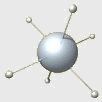|
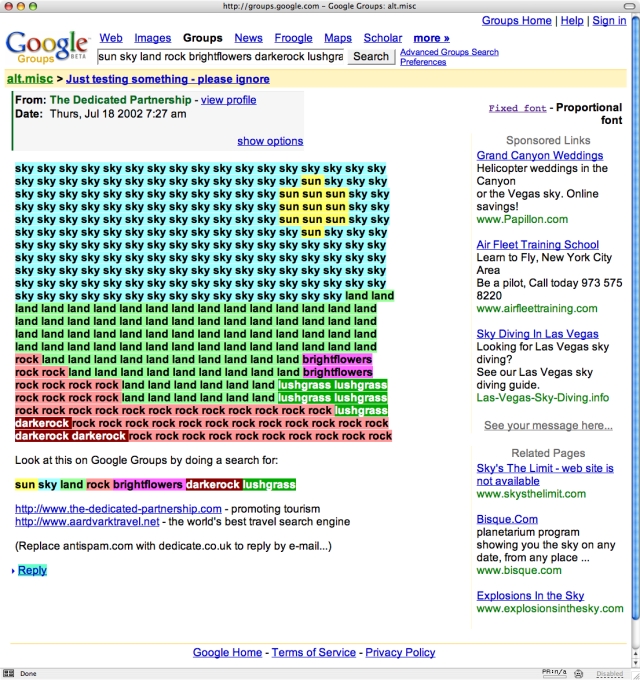
Figure 3. Tim Flaherty, Stuart Langridge et al., Google Groups Art in action. http://www.kryogenix.org/code/browser/aqgoogle, accessed February 9, 2006.
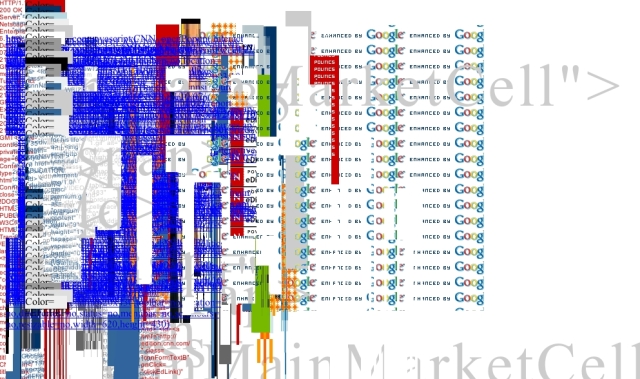
Figure 4. Mark Napier, Shredder, as applied to Google.com/eBay.com.
As these examples demonstrate, some of the most renowned online artists take Freud's notion of polymorphous perversion to an automated extreme, following Cornelia Solfrank's dictum, "A smart artist makes the machine do all the work." [3]
Execution
If perversion is a 21st-century artist's most potent technique for producing cultural forms, execution is her most potent technique for distributing them. "To execute" is computer parlance for the act of running a program, as when a user launches a word-processor or spreadsheet – but the term's meaning can be extended to include triggering an existing system to discharge a task that changes the state of that system. Executable art hijacks today's computational, legal, and economic networks, propagating outside the studio or gallery to affect distant people and events:
-Joe Davis hijacks the reproductive mechanism of E. coli by drawing a picture in its DNA and then unleashing this "infogene" into the natural ecosystem.
-Tom Ray hijacks a computer network to breed computer viruses by designing a wildlife sanctuary that enables them to migrate from hard drive to hard drive.
-The Yes Men hijack the Web domain DowEthics.com and use this parodic site to announce a public apology for the Bhopal gas disaster, dropping Dow's share price 4.2% in 23 minutes.
-Dave Touretzky hijacks the concept of a gallery to showcase songs, haikus, and T-shirts that feature copyright-thwarting code, swaying a federal judge's argument about the boundary between free and "illegal" expression.[Fig. 5]
-MetaMute magazine hijacks ECHELON by promulgating online fiction laced with trigger words designed to decoy this global surveillance network. [Fig. 6]
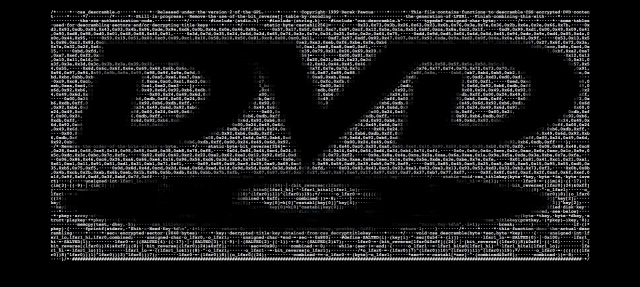
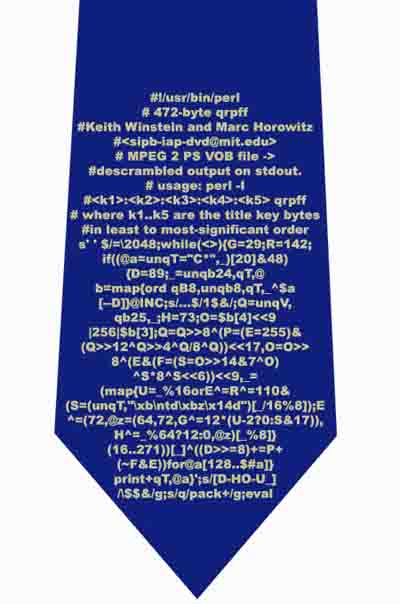
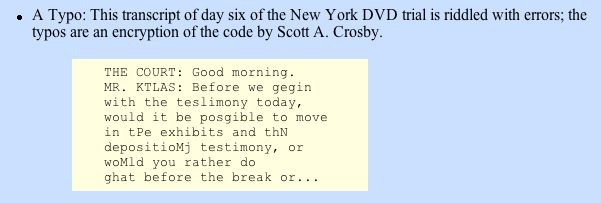 Figure 5. The "illegal" code for copying a DVD as rendered in the DVD logo, a tie, and typos in a transcript of the trial of publishers of the code. Featured in Dave Touretzky's Gallery of CSS DeScramblers, http://www.cs.cmu.edu/~dst/DeCSS/Gallery, accessed February 9, 2006.
Figure 5. The "illegal" code for copying a DVD as rendered in the DVD logo, a tie, and typos in a transcript of the trial of publishers of the code. Featured in Dave Touretzky's Gallery of CSS DeScramblers, http://www.cs.cmu.edu/~dst/DeCSS/Gallery, accessed February 9, 2006.
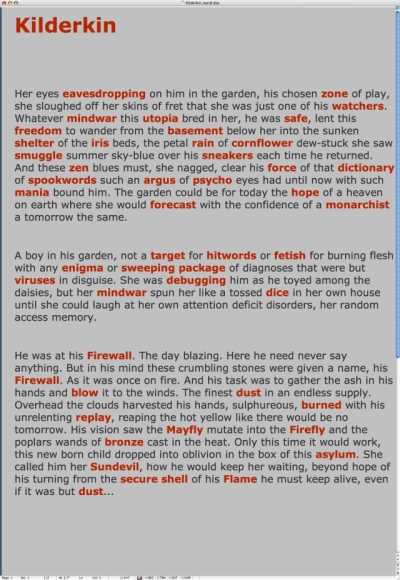 Figure 6. "Kinderkin," one of the entries in the Metamute ECHELON literary context. This example of "executable literature" has been highlighted to show trigger words designed to fool a government spy network.
Figure 6. "Kinderkin," one of the entries in the Metamute ECHELON literary context. This example of "executable literature" has been highlighted to show trigger words designed to fool a government spy network.
Literature has long held the power to sway its readers' hearts and minds, but executable literature does this by acting directly on the networked infrastructures of power woven through the digital fabric of contemporary life. If traditional literature produces satisfaction through catharsis while leaving the world's injustices unchanged, executable literature produces satisfaction through engagement – acting directly on sites of injustice.
Viral Powers
Some have described the new powers art wields once released from the art world, such as perversion and execution, as viral. Andy Warhol is said to have updated his prediction that everyone would be famous for 15 minutes to the claim that "in 15 minutes, everyone will be famous." [4] While either claim seemed unrealistic in 1968, the advent of a "Warhol worm" in 2003 – a virus that infected 90% of vulnerable computers within 10 minutes – put that fantasy within reach. Commercial photographer Oliviero Toscani, who shoots in-your-face political images that have turned magazine ads and bus placards from advertising into agitprop, also reaches a wide audience. His ads for the "United Colors of Benetton" marketing campaign feature images of ten-story-high condoms to increase AIDS awareness and three beef hearts labeled "WHITE BLACK YELLOW" to reveal the absurd dynamics of racism. [Fig. 7] "I act as a virus against the commercial world," Toscani avowed. "Art is a virus." [5]
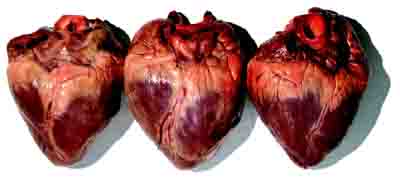 Figure 7. Oliviero Toscani's photographs from his "United Colors of Benetton" campaign. http://olivierotoscani.com/, accessed February 9, 2006.
Figure 7. Oliviero Toscani's photographs from his "United Colors of Benetton" campaign. http://olivierotoscani.com/, accessed February 9, 2006.
The viral metaphor is indeed tempting: viruses are perverse – they mutate; and executable – they hijack the host's means of replication to further their own proliferation. However, viruses originate outside a host organism and are interested in that organism's surviving only long enough to enable it to infect other hosts. Art, on the other hand, originates in and is symbiotic with the larger social body. Its long-term survival – and, many would say, its meaning – depends on the survival of the cultures it celebrates or critiques.
Of course, artists are not always comfortable being associated with society, and the feeling is mutual. But with rare exceptions like Goebbel's book-burnings and Stalin's poet-purges, no Euro-ethnic society since Plato's Greece has really succeeded in booting artists out altogether; they may be a social irritant, a fly in the ointment, but they are part of the culture along with village idiots, criminals, and used-car salesmen. Art is an unruly, pesky, troubling symbiont. Indeed, the goal of an artist is not to expend or destroy society but to serve as an internalized image of what society is not.
This is a daunting task, and one for which Euro-ethnic cultures offer no obvious model. The best metaphor for art's contemporary role may be a microbe, but one internal rather than external: the antibody.
Antibodies Are Perverse
The job of an antibody is to keep up with viruses, so it's not surprising that antibodies share many of the same powers as viruses – including perversion and execution. Antibodies are proteins dangling on the surface of a class of white blood cells called the lymphocytes. Trillions of antibodies course through the bloodstream, each a complex organic molecule twisted into a distinctive three-dimensional shape that serves as a unique portrait of a particular foreign agent. Antibodies make reliable detectors of viruses and other foreign lumps of protein because for any given virus there will be only one antibody that exactly dovetails with it. A small fraction of antibodies are inherited from the mother in the womb; the body makes the rest. But it's no mean feat to generate a cellular database of foreign dangers you have never encountered. How can the body tell what chicken pox looks like without letting some inside its skin?
The answer lies in an ingenious mechanism described by biologist Gerald Edelman as a genetic "jumbler." Like everything else in a cell, the exact shape of the protein dangling from a lymphocyte is determined genetically. Unlike the stable genes for its membrane or nucleus, however, the genetic material corresponding to a lymphocyte's receptor is prone to shuffle itself during cell reproduction. As a consequence of this built-in randomizer, each of the billions of lymphocytes initially produced by the body bears a different chemical "lure" on its surface. Even if a chicken pox virus has never entered the bloodstream before, there's probably a white blood cell somewhere with a protein to match. That's how the immune system "knows" what chicken pox looks like before it even encounters it.
Online artists manipulate digital code to make art much as the immune system manipulates genetic code to make antibodies. Like the immune system’s polymorphous antibody production, this perverse practice lends code art a quirky and prophetic vision that is unlikely to emerge from a purely utilitarian approach. The misuse of genetic code – which might prove lethal elsewhere in the body – allows the immune system to anticipate shapes it has never encountered. Artists employ a similarly wrongheaded strategy, playfully misusing computer, genetic, and social codes to reveal the ways in which society is being shaped by new technological and political forces. [Fig. 8]
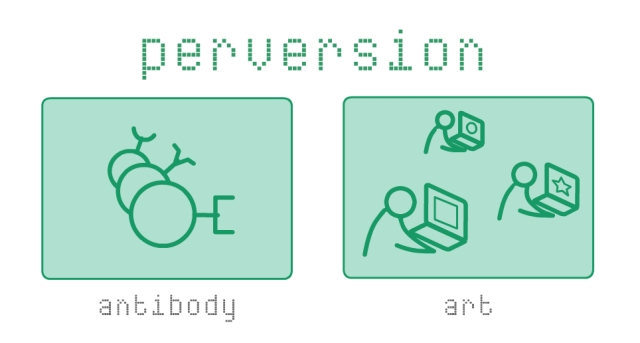
Figure 8. Perversion is the ability to misuse codes, whether genetic, technological, or social, to produce new forms of biological or cultural expression. Diagram drawn from Joline Blais and Jon Ippolito, At the Edge of Art (Thames & Hudson: London, 2006).
Antibodies Are Executable
When it comes to executing code – especially the DNA that controls their own reproduction – lymphocytes are trigger-happy. If an antibody ever finds and latches onto its complementary virus, the match turns the lymphocyte into a chemical warning beacon. Even more importantly, the activated lymphocyte also undergoes the microbial equivalent of going into heat: it divides like crazy, filling the bloodstream with countless clones of itself, each of which is perfectly shaped to link up with the offending invader.
A stimulated lymphocyte creates new antibodies at the astounding rate of 10,000 molecules per cell per second [6], triggering a systemic change in the lymphatic and circulatory systems. At first the bloodstream may contain only a handful of antibodies to match a chicken pox virus, but thanks to the executability of genetic code, within a few days billions of chicken pox will meet their match.
"To execute," in the world of genetic or computer code, means to turn the potential power of instructions into the actual power of behavior. But there are many codes at play in both the immunological and social bodies. The immune system executes its code when it recognizes invasion of the body by foreign code (e.g. a virus); digital art executes its code when it recognizes invasion of the social body by codes that appear foreign or harmful, whether they are cultural, legal, or social. [Fig. 9]
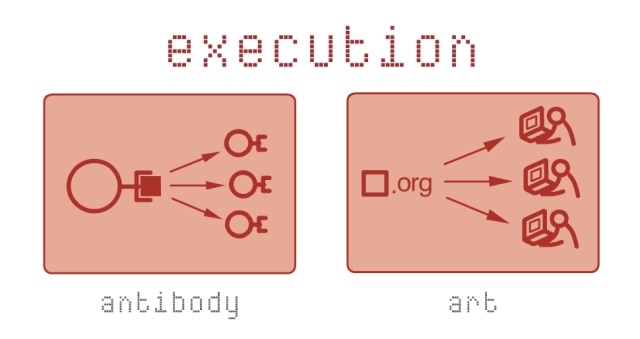 Figure 9. Whether exploited by antibodies or artists, execution is the triggering of an existing system to automate a task that changes the state of that system. Diagram drawn from Joline Blais and Jon Ippolito, At the Edge of Art (Thames & Hudson: London, 2006).
Figure 9. Whether exploited by antibodies or artists, execution is the triggering of an existing system to automate a task that changes the state of that system. Diagram drawn from Joline Blais and Jon Ippolito, At the Edge of Art (Thames & Hudson: London, 2006).
Antibodies Are Liminal
So far it would seem that antibodies and viruses operate by comparable mechanisms, but they just happen to be on opposite sides of the ongoing battle for dominance in the bloodstream. But antibodies are accountable in ways that viruses are not, which is what makes them a more interesting metaphor for art of the Internet age. Antibodies are mechanisms for envisioning and populating the body with alien forms. They occupy a liminal space between self and other, not entirely under the control of either.
If antibodies are the avant-garde of the immune system, they are not subservient to a top-down command and control system. Although biologists once assumed that the body instructed the immune system how to respond to a chicken pox virus, subsequent discoveries proved the exact opposite: antibodies function by a bottom-up model, by selection rather than instruction. The bone marrow produces a million varieties of antibodies, 99% of which, it must be said, will never serve any function whatsoever. It is only when an antibody coursing through the bloodstream happens to match up with a foreign body that it reproduces wildly, countering the pathogen's invasion in the short term and lingering in the bloodstream to form a somatic memory in the long term.
Similarly, the NEA shouldn't tell artists what subjects to paint or code to write. Like the B-cells on the immune system's front line, artists are better positioned than any centralized establishment to spot and confront pressing cultural issues, whether technological (gene harvesting), legal (music piracy), or personal (online intimacy). Dispersed across scientific labs, virtual communities, and street corners rather than cosseted in studios and concert halls, artists represent a grass-roots defense against invasive cultural memes.
Of course, even a grass-roots defense is still defensive – a truism that would seem to cast doubt on the immune system as a metaphor for the newfound, pro-active power that art wields in the Internet age. After all, isn't much of the motivation for art's eruption outside of galleries and museums precisely to avoid the emasculation of power that attends its circumscription by the white cube of art? Aren't today's creative thinkers targeting the stock exchange, global surveillance networks, and restrictive copyright laws precisely because they think these are unhealthy institutions that need attacking rather than healthy institutions that need defending?
To answer this reasonable objection requires a more nuanced look at the immune system. Natural antibodies, like components in many complex adaptive systems, work to keep the system in balance with its environment. No mammal would ever have evolved without some means of maintaining a balance of power between self and other; over the past 500 million years, immune systems have endowed vertebrate metabolisms with just enough stability for their populations to co-evolve into complex and variegated ecologies. For healthy organisms, this has often meant disarming malignant invaders, as in the case of smallpox and malaria. On occasion, it has meant welcoming them into a synergistic relationship with the host, as in the case of mitochondria or E. coli. This encounter with otherness is healthy for the entire ecosystem; it is not a colonial mission to diminish otherness outside the body. [7] The immune system is the aperture, the valve that opens or closes the body to the rest of the microbial world.
There are times, however, when the animal byproducts of evolution are unsustainable – when an organism's metabolism is out of balance with its environment, and perhaps shouldn't survive, at least in its current form. Indeed, sometimes the body defends itself all too well [8], at which point the immune system's mission of defending the body is no longer warranted. When the body's intolerance of otherness means that no aliens cross the skin barrier, when the flow of information across the immune aperture gets squeezed to a trickle, the immune system can turn on its own host.
In biology, this condition is called "autoimmunity": the organism quite literally no longer recognizes itself, and its antibodies challenge the body's own tissues instead of foreign agents. In systemic autoimmune disorders such as Lupus, antibodies target the entire body. In other autoimmune responses, antibodies target specific aspects of self: the skin in Psoriasis; the pancreas in Type 1 Diabetes; nerves in Multiple Sclerosis; bone joints in Rheumatoid Arthritis. Interestingly, epidemiologists have noted an inverse relationship between infectious diseases and autoimmune disorders. [9] In cultures where smallpox or malaria is rampant, autoimmune diseases are rare, while in those with relatively few external scourges, the immune system appears more likely to target its own host. It is as though the immune system expects a steady diet of otherness from the external environment, and if it doesn't find enough otherness outside, it looks for otherness inside.
Contemporary human bodies are more-or-less stable products of evolution, and cases of autoimmunity among human populations can result in tragic suffering or at best annoyance and discomfort. The situation is not as clear for our social body at the beginning of the 21st century, which by many accounts is wildly out of balance with its environment – from the overreach of corporate interests, to the relentless proliferation of technology, to the reckless provocation of global climate change – and needs drastic readjustment. If that is true, then art can act as an antibody and still assault its own culture.
Step back to view these diametrically opposed conditions – art as defender or attacker – from a more expansive perspective. The Yes Men's Gatt.org project uses the perversity of Reamweaver [10] and the executability of the Web's Domain Name System to undermine the credibility of the World Trade Organization. The Yes Men could say that the WTO is an internal menace contributing to an unhealthy social body. Or the Yes Men could say the WTO is an external threat to a healthy social body – a corporate giveaway that seeks to undermine a just society via unnatural technological and economic controls. From the standpoint of the co-evolution of an organism with its environment, it ultimately doesn't matter whether a threat is internal or external; for systems far from equilibrium, the distinction between self and other breaks down anyway. What is important is how art goes about challenging these threats.
The Limits of Artistic Influence
Art of the Internet age has the double-edged character of antibodies: it can defend or assail its host depending on the context. But even when art challenges its own society, its accountability differs from the accountability of direct political intervention, either from the inside or outside. A social body, like the human body, is not a free-for-all, but a complex set of feedback mechanisms. Whether her weapon is a pistol or a press conference, a political activist with bad politics can wreak suffering and destruction on the world. Artists, on the other hand, must be free to explore unconventional, untested, even dangerous values with impunity. If anything, this makes artists more accountable than antibodies: they must exercise care for the social body even when they attack it. In return for the "artistic license" that allows her to explore risky themes, a creator must take care to undermine rather than overpower, to impose questions rather than answers.
For its part, society must tolerate a perverse multitude of artistic investigations and directions, just as the biological body tolerates the perverse alien forms produced by antibodies. Like antibodies, the arts are an inefficient drain on the body's resources; and like antibodies, the arts are worth it. The job of an artist, like that of the antibody, is to conjure possible threats to the body, real and imagined. While this conjuring may not put the body directly at risk, nevertheless reactionary impulses are likely to see these conjurings as more dangerous than they really are – not because they threaten life and limb, but because they threaten current and unjust structures of power and wealth often hidden by ideological blinders. This is why, for example, the Yes Men call their work "identity correction"; in their words, "Honest people impersonate big-time criminals in order to publicly humiliate them. Targets are leaders and big corporations who put profits ahead of everything else." [11] [Fig. 10]
 Figure 10. The Yes Men, ersatz version of the USA Patriot Pledge, http://www.theyesmen.com, accessed June 30, 2006.
Figure 10. The Yes Men, ersatz version of the USA Patriot Pledge, http://www.theyesmen.com, accessed June 30, 2006.
That is not to say art can't do damage, but that this damage often stems from revelation rather than ruin. There is nothing artistic about Union Carbide's secret decision to test unproven technologies [12] at a gas plant in Bhopal in 1984, which resulted in 15,000 deaths and hundreds of thousands of injuries. However, when the Yes Men hijacked the domain DowEthics.com to publicize an ersatz apology for Union Carbide's parent corporation, it was more than an innocuous prank. The $2 billion Dow's market value lost in a matter of minutes was an artistic victory – a revelation of Dow's tenuous standing given its history of unethical and unsustainable business practices – an "other" position that the social body had to date been unprepared to accept.
As noted above, the Yes Men also used their parodic prowess to undermine the World Trade Organization and its policies of global exploitation. Does this mean the September 11th Al Qaeda attacks on the World Trade Center were likewise a work of art, revealing the vulnerability of US hegemony in an increasingly globalized world? Contemporary artists Karlheinz Stockhausen [13] and Damien Hirst [14] thought so, applauding the 9/11 terrorist attacks as "the greatest work of art ever." But the revelation produced by the destruction of the twin towers took the form of certainty; whatever confusion immediately ensued, there was nothing curious or intriguing about 2,752 bodies burned and crushed to death. Artists should not be allowed this form of power, and Stockhausen and Hirst both apologized later for their appalling category error.
Likewise, Joe Davis's "infogene" would cease to be art if his genetic intervention turned E. coli into a vector for anthrax. Indeed, some critics of experimenters like Davis rightly question the accountability of the techniques of genetic engineering, whether in the hands of artists or biotech firms. In contrast, the recent jailing of artist Steve Kurtz, held without charge on terrorist charges for owning petri dishes and other basic labware, reminds us of the importance of protecting artists and their research into avenues that are conceptually dangerous, if not physically so. Even the law eventually came to this conclusion in Kurtz's case, as the authorities were forced to drop every charge against him except mail fraud.
The influence of today's art may extend outside the art world's hallowed halls to infiltrate chat rooms, courtrooms, and bedrooms – but it is still influence rather than power.
References:
[1] Shelley reserved for poets a prophetic vision that resonates with the antibody metaphor explored in this essay: "Poetry strengthens the faculty which is the organ of the moral nature of man, in the same manner as exercise strengthens a limb. [… Poets] measure the circumference and sound the depths of human nature with a comprehensive and all penetrating spirit, and they are themselves perhaps the most sincerely astonished at its manifestations; for it is less their spirit than the spirit of the age. Poets are the hierophants of an unapprehended inspiration; the mirrors of the gigantic shadows which futurity casts upon the present; the words which express what they understand not; the trumpets which sing to battle, and feel not what they inspire; the influence which is moved not, but moves. Poets are the unacknowledged legislators of the world." Percy Bysshe Shelley, "Defence of Poetry" (1819), mirrored at http://www.fordham.edu/halsall/mod/shelley-poetry.html, accessed June 30, 2006.
[2] Joline Blais and Jon Ippolito, At the Edge of Art (Thames & Hudson: London, UK, 2006), p. 7.
[3] Ibid., p. 17.
[4] See http://en.wikipedia.org/wiki/Warhol, accessed June 30, 2006.
[5] Ibid. [2], p. 9.
[6] "Warriors of Your Immune System" at http://www.mansfieldct.org/schools/mms/staff/hand/Warriorsimm.htm, accessed June 30, 2006.
[7] Indigenous cultures often appreciate otherness when trading with outsiders, but they will also defend their communities against attack. In such balanced cultures, art maintains the culture; in unsustainable cultures, art rightly destabilizes the status quo.
[8] The vaccine controversy offers one example of how diminished exposure to otherness may be counterproductive to the body. Opponents of routine inoculation argue that exposure to the attenuated viruses in vaccines provides only partial, short-term immunity, whereas exposure to real viruses in the wild confers a stronger community, especially to the overall population.
[9] See http://en.wikipedia.org/wiki/Autoimmunity, accessed June 30, 2006.
[10] http://www.reamweaver.com/, accessed June 30, 2006.
[11] http://www.theyesmen.org/, accessed June 30, 2006.
[12] http://en.wikipedia.org/wiki/Bhopal_disaster, accessed June 30, 2006.
[13] Ibid. [2], p. 134.
[14] Charlie Gere, Art, Time, and Technology (Berg Press: Oxford, 2006), p. 177. |
